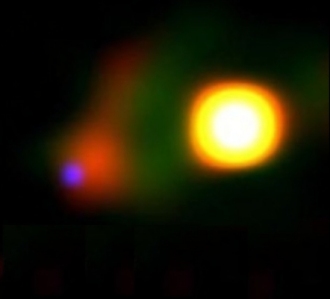|

Mira, also known as Omicron Ceti, is estimated tp be
200-400 light years away in the constellation Cetus. A binary star
system, it consists of a cool, pulsating giant, the famous star Mira A,
and a low-mass companion, Mira B, which is accreting matter that has
been shed by its larger partner.
In Star Trek, Omicron Ceti III, the site of a colony
established in 2264. The Enterprise's was sent there to catalog its
destruction under the bombardment of deadly berthold rays, which were
only discovered after the colonists left Earth. However, they discover
that Elias Sandoval and the other colonists are not dead after all. The
Omicron pod plant discovered on planet Omicron Ceti III by botanist
Leila Kalomi served as a repository for the Omicron spore, and squirts
them out of its flower at anyone uninfected who comes too close. When
the inhabitants of Omicron colony tried to infect the crew of the USS
Enterprise with the spores, an infected Doctor Leonard H. McCoy had
numerous pod plants beamed up to the ship, where the spores quickly
spread through the ventilation system. (TOS: "This Side of Paradise")
Another planet in the Mira system, Dytallix B, was
visited by the USS Enterprise-D in 2364. Prior to the 2360s, Dytallix B
had was mined for the Federation by the Dytallix Mining Company. The
mines were located in the temperate zones between the day and night
hemispheres. By 2364 the mines were long abandoned and were used a
secret meeting place by Starfleet Captains Walker Keel, Rixx, Tryla
Scott, and Jean-Luc Picard to discuss the infiltration of Starfleet
Command by neural parasites. (TNG: "Conspiracy") (TNG: "Conspiracy")
In astronomy, Mira A lies on the so-called asymptotic
giant branch of the Hertzsprung-Russell diagram. It is pulsating
variable whose brightness ranges from 2.0 to 10.1 and spectral type
from M6e to M9e III over a period of 331.96 days as its surface rises
and falls. Visible to the naked eye at its brightest, Mira can be seen
only with optical aid for most of its cycle. It is the prototype and
brightest long-period variable or Mira star, and was give its name
(meaning “wonderful”) by David Fabricius, who was the first to record
its brightness fluctuations in 1596. This very luminous and hugely
distended star has a diameter of about 650 million km (over 400 million
miles) so that it could comfortably swallow the orbit of Mars. Hubble
Space Telescope observations have shown that, like some other stars of
its type (including R Leonis and W Hydrae), it is conspicuously
egg-shaped. Mira’s great size and instability result in a stellar wind
that will eventually blow away the star's outer envelope, forming a
planetary nebula and leaving behind a white dwarf.
Mira B, also known as VZ Ceti, is separated from Mira A
by an average distance of about 100 AU and the two stars complete an
orbit around each other in roughly 500 years. Although astronomers used
to think that Mira B was a white dwarf, recent evidence suggests that
it is a main sequence star with about half the mass of the Sun. The
erratic variability of Mira B are probabaly connected with its capture
of matter from Mira's stellar wind, making Mira B what is known as a
symbiotic star. Mira B accretes as much as one percent of the matter
lost by its primary.
In January 2007, a group of astronomers using the the
Keck Observatory in Hawaii and the Gemini South telescope in Chile
reported the discovery of a protoplanetary disk around Mira B raising
the unexpected possibility that planets may form from material shed by
dying stars. Though planet formation is perhaps unlikely as long as the
disk is in active accretion, it may proceed rapidly once Mira A passes
through its giant phase and becomes a white dwarf. Furthermore, if
planets do form they will have a palnetiful source of the raw materials
necessary for life, including carbon.
The disk around Mira B currently contains less than a
Jupiter's worth of material. However, this is likely to increase to
between three and five Jupiters' worth of matter before the accretion
process ends – roughly the mass needed to form a planetary system like
our own. In addition to the light from the ordinary star, any planets
that form will be bathed in the pale glow of the white dwarf, which
would appear about as bright as a crescent Moon.
|
|
